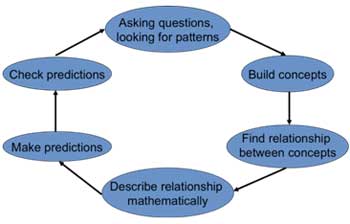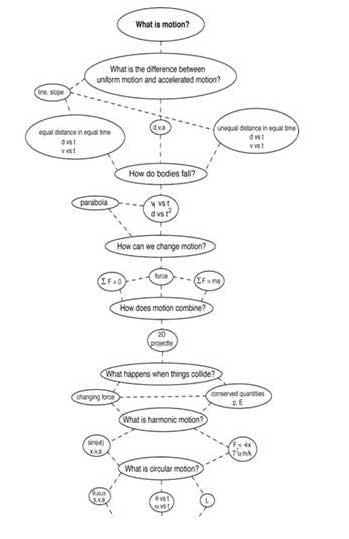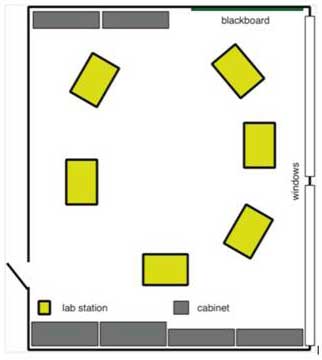The Application Of Play Theory to Pedagogical Design
Juan Burciaga
At one time course preparation (metaphorically speaking) was simply dividing up the textbook into 39 daily chunks and then inserting timely tests. But as our understanding of the complex learning environment, and of our responsibility for that environment, have grown, faculty are increasingly called upon to attend to social construction within the course, maintain a constructivist learning environment, address affective objectives, and secure the engagement and motivation of a diverse student population. Play theory offers a framework to inform, balance, and interpret these new, and frequently conflicting, pedagogical demands.
Why play?
But by "applying play theory to curriculum development" I do not mean using games to make aspects of instruction more palatable, nor even that learning can be a form of play. Instead my main argument is:
Playing can be part of the learning process because the subject to be learnt is, at least in some respects, essentially playful. [1]
We should not think of a game as a way to make physics more fun, but instead focus on showing how much of physics is play. In order to incorporate this insight we need to rethink physics in order to understand, illuminate, and engage the fundamentally playful nature of physics. A second factor that helps explain how play theory can be useful to curriculum developers is that the core aim of play is the organization of experience. In other words, the purpose of a game is not really the solution of a task but the ordering and shaping of the experience of the game by the players, i.e., it’s not if you win but how you play the game. Or, from our expectations, it’s not the answer but how you ask questions, get the answer, and check to see if you have it right.
Too often we focus our assessment on the before and after, and not on the day-to-day experience of the learners (or in this paradigm, of the players). Even when we assess on a daily basis, the emphasis of the assessment is frequently on what have they learned and rarely on how they are experiencing the course. When we are able to re-imagine a course in this paradigm then a course is imbued with the fundamental values of exploratory learning, curiosity, and risk-taking, since the course is partially developed in response to the active design and execution of the actions of the learners.
Properties of play
In this paradigm, each course can be thought of as a game and the teacher a game designer. In many ways this perspective is a familiar one for those teachers who think that as teachers all we can do is to set the learning environment. For curriculum development a useful definition of play summarized from Johann Huizinga’s seminal work is:
Play is a free and meaningful activity, carried out for its own sake, spatially and temporally segregated from the requirements of practical life, and bound by a self-contained set of rules that hold absolutely. [2]
Several properties of play determine how curriculum developers may effectively apply play theory to curricular design. Play takes place in a "magic circle" (chessboard, baseball field, backyard, etc) separated from daily life in space and time where the rules of the game hold true. In the magic circle, players are tested (strength, speed, reasoning, etc) against "something else" according to the rules [1]. This magic circle informs the players (students) that the rules of the game are in force and demands that they engage the learning under the rules developed by the game designer (the teacher).
The magic circle for a lab course is well-defined but for a lecture course the magic circle may be somewhat ambiguous since the learning environment extends beyond the classroom and encompasses many environments. Generally, in a game the "something else" or "other" that players are tested against may be another person or team, an idealized performance, or an inanimate challenge. In physics, "the other" that physicists are measured against is the physical universe, or more precisely their understanding of the physical universe.
The rules are developed from the objectives of the course. But these rules have specific constraints and most of these constraints are centered on the concept of "fair play." In addition, the rules help focus the actions of the game in a way that the play makes sense and carries meaning for the players. If players do something right there is a reward and if they do something wrong they are penalized. Although the rules may be explained, how they fit into particular situations is not readily determined. Thus there should be room and time to explore. This ambiguity opens the game to rhythm.
In play there is risk, the chance to get it wrong. So there is always dynamic interplay of action and reaction between players and the other. This pattern establishes a rhythm to the play experience. To capture the intensity of the experience we need to focus on the feeling of risk, anticipation, effort, rhythm, and sense of fair play. Under the play paradigm, assessment of a learning situation must incorporate monitoring the experience of the players (students) during the game (learning).
An example: The physics laboratory
We can make these ideas a little more concrete by looking at an example—the physics laboratory for an introductory course. Let us take a course that is populated by students of diverse majors and is the first physics course at the college level. In the interests of total disclosure, the lab I am discussing was not actually designed within the paradigm of play theory. The design of the lab experience grew organically as do much of our courses. But several years ago, as I was reflecting on why the course design was so effective, I came across the potential application of play theory to curricular design. The lab manual, the TA manual, and the faculty handbook for the lab experience are available from a pedagogical archive maintained by the American Association of Medical Colleges [3].
- Students develop an ability to pose questions, pursue answers to those questions, evaluate the answers, modify their inquiry, and develop new questions.
- Students make an extended inquiry, i.e., students repeatedly trace the development of phenomena from observations, through conceptual understanding, to a rough mathematical model, to developing predictive criteria, and finally to a refined model of the physical world.
- Students learn how to work effectively in a group both in their lab groups and as part of a community of researchers, scholars, and explorers with responsibilities to that community.
- Students also have the opportunity to see themselves as effective and valued members of that community of scholars.
These objectives can be summarized in three general rules:
Work as a Team.
Learn to Ask Questions.
Pursue Extended Inquiry.
Work as a team
Much of the social interaction we are promoting was developed and assessed in group work. We modified the Cooperative Group roles developed for problem solving in physics [4] for the laboratory environment. Thus students were educated in cooperative group work. In order to demonstrate the benefits of the approach, the Lab Questions were designed to be complex enough that the students needed other group members to successfully engage the lab experience. In addition, we communicated to the students (repeatedly) that the emphasis of the lab assessment is in how well the group is pursuing their assigned roles and developing their inquiry. The assessment rubrics used to measure the level and quality of the social engagement depended on monitoring the conversation of the students as they interacted with one another and generated their investigation. But by monitoring the level of engagement we were also paying close attention to the experience of the lab environment from the perspective of the "players".
Learn to ask questions

Learning Cycle 1: Cycle used by students to start generating their inquiry.

Learning Cycle 2: Lab questions were designed on this pattern of inquiry.

Learning Cycle 3: Learning cycle used by lab instructors to give feedback to the students both orally and through written comments.

Storyline:An example linking the Lab Questions.

The magic circle: Room setup for the introductory lab.
From the perspective of a student, one of the most daunting demands of an inquiry-based lab is how to ask questions that lead to a useful investigation. In order to educate students in this aspect of the lab experience three separate learning cycles were incorporated. The first day of the lab began with a Lab Question that required students to generate an investigation to answer. Students were thus asked to generate an inquiry including most of the procedure and data recording, analysis, and interpretation. The student groups were guided in their inquiry and every 1–3 weeks encountered another Lab Question that seemed to arise naturally from the inquiry they had generated. In order to start their discussion of how to begin thinking of generating their inquiry Students were instructed to ask the three questions of Learning Cycle 1.
Although students were explicitly asked to pursue this set of questions for their inquiry, a successful pursuit involved a second learning cycle that students needed to apply.
Finally, the lab instructors guided the inquiry of the students by using a third set of questions to capture where the students were in their investigation, how they were thinking of their inquiry, and which allowed us to guide them to the next step of the inquiry. This pattern was used in both visits from the lab instructors and also in written comments in their lab journals.
The guidance offered by the lab instructors was very sparse at the beginning of the semester and was progressively reduced as the semester continued. By the end of the semester, the lab groups were able to pursue Projects, a 3-week-long inquiry into a system they had not encountered and successfully generate an extended investigation with virtually no input from the lab faculty.
The use of these learning cycles led to an unintended but beneficial development. By constructing the experience about these learning cycles, we imposed a rhythm of thought, action, and experience. Play theory sheds light on the importance of this aspect to better engage the attention of the students and enhance the level of meaning to the lab tasks. Rubrics based on the discussions among the students were used to assess the quality of the critical inquiry. By monitoring the level of critical inquiry, we were also paying close attention to the experience of the lab environment from the perspective of the "players."
Pursue extended inquiry
The idea that all experiments have a known answer and can be verified in 3 hours is a common perception among students at the introductory level. A key element of the lab experience was to emphasize that an inquiry may continue indefinitely as the questions being asked are answered, redefined, and extended. This is possible since the Lab Questions are linked by a storyline allowing students to pursue and discover extended patterns as a result of their investigation. The assessment rubrics (used to monitor the students ability to pursue an extended inquiry) allowed us to pay close attention to the experience of the lab environment from the perspective of the "players".
In addition, a "magic circle" of the lab room reflected the design of the curriculum. There is no center of authority and each lab station has equal status. Each lab station was separate and relatively private so that each group could develop their own investigation but stations faced one another across a common environment to encourage interaction and sharing. Each lab station had a complete set of equipment so the students have the ability to pursue and modify their inquiry independent of other groups or of the faculty.
Further explorations
Applying the paradigm of play theory to the lab course (particularly the introductory lab) is straightforward. However applying it to a lecture course is more problematic. Identifying the play elements in a theory/problem-based course needs additional work. Developing those activities that bring out the play elements of a theory course and assessment protocols that can assess learning in the extended environment of non-lab courses are other aspects that need attention.
In addition to the works already cited, faculty may wish to examine the comments on play theory in physics pedagogy in College Teaching and the Development of Reasoning [5] and the abridged reprints in the Game Design Reader [6].
References
[1] H. Rodriguez, "The Playful and the Serious: An Approximation to Huizinga’s ‘Homo Ludens’," Game studies: The international journal of computer game research, Vol. 6, Dec. 2006.
[2] J. Huizinga, Homo Ludens (London, Routledge, 1949).
[3] J.R. Burciaga, "Crafting the Laboratory Experience: An Exercise in Pedagogical Design, Development and Assessment," MedEdPORTAL (2010).
[4] P. Heller and K. Heller. "Cooperative Group Problem Solving in Physics," University of Minnesota (1999).
[5] R.G. Fuller, T.C. Campbell, D.I. Dykstra, Jr., S.M. Stevens (eds.), College Teaching and the Development of Reasoning, (Information Age Publishing, 2009).
[6] K. Salen and E. Zimmerman, The Game Design Reader: A Rules of Play Anthology, (Cambridge, MIT Press, 2006).
Juan Burciaga teaches in the Department of Physics and Astronomy at Denison University, OH.
Disclaimer - The articles and opinion pieces found in this issue of the APS Forum on Education Newsletter are not peer refereed and represent solely the views of the authors and not necessarily the views of the APS.
